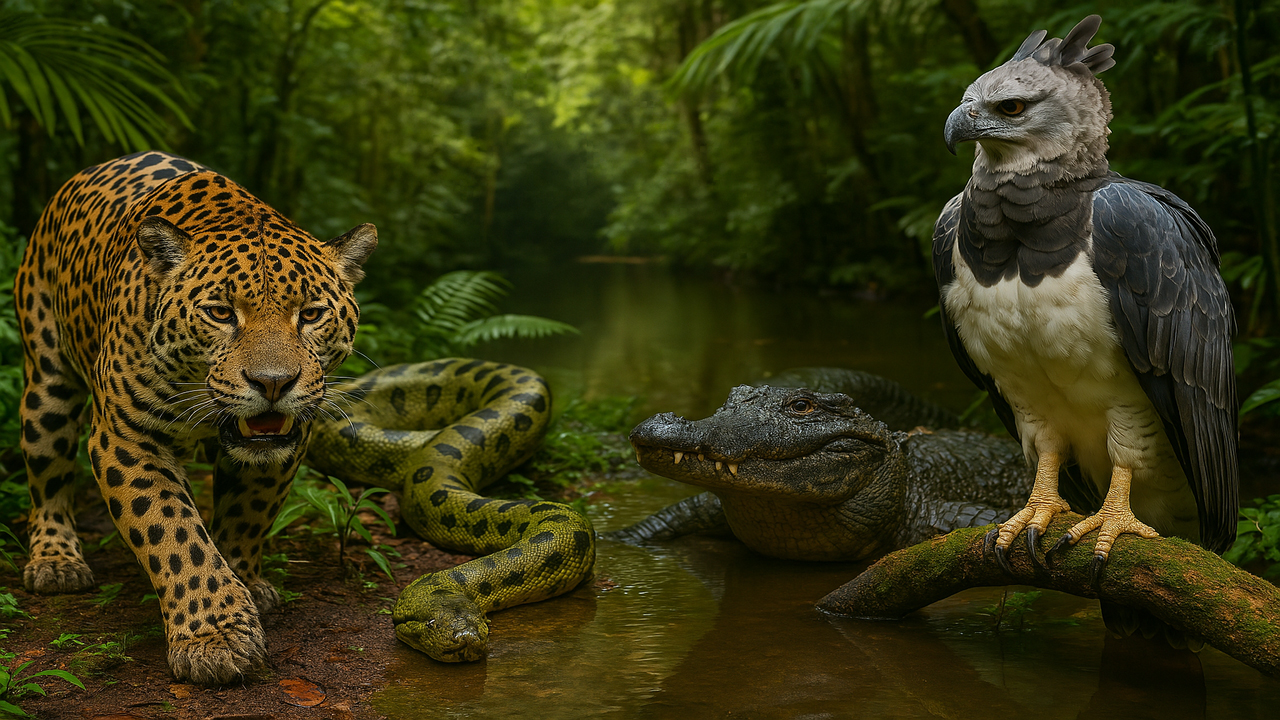
Top 10 Species Wildest Predatory Animals in Brazilian Amazon Forest
Top Ten Things – Discover the Top 10 Species Wildest Predatory Animals in the Amazon
The Brazilian Amazon Forest is home to the most breathtaking wildlife on the planet. Deep within its lush green wilderness roam some of the species wildest predatory animals that nature has ever produced. These predators play a crucial role in maintaining the balance of the forest’s fragile ecosystem. From stealthy stalkers to powerful hunters, each animal has evolved with unique survival skills. According to Top Ten Things (toptenthings.com), these ten species represent the true force of nature in action.
Below are the top 10 wildest predators that rule the Amazon with strength, speed, and cunning:
The jaguar is the king of Amazon predators and the largest feline in the Americas. It hunts silently through the forest, capable of crushing skulls with one powerful bite. This cat can climb, swim, and even hunt underwater prey. Its diet includes capybaras, caimans, and even anacondas.
“Read more : Top 10 Biggest UFC Sports Stadium in the World with the largest Audience Capacity“
The green anaconda is the heaviest snake in the world and a master of ambush. It waits underwater for prey such as birds, fish, and mammals. Once caught, it coils its body to suffocate the animal before swallowing it whole. Reports by Top Ten Things highlight its terrifying strength and stealth.
Black caimans are apex predators in Amazonian rivers and swamps. With razor-sharp teeth and unmatched patience, they stalk capybaras, deer, and monkeys. They can remain still for hours before launching a deadly strike. Their dark skin helps them blend into the night waters.
The harpy eagle dominates the skies above the rainforest canopy. It preys on sloths and monkeys, snatching them mid-air with powerful talons. Its wings may be short, but they allow it to fly between tight trees. It is one of the strongest eagles in the world.
Don’t let its playful look fool you—the giant otter is a fierce predator. It hunts in groups, displaying teamwork that overwhelms even large fish. They are known to challenge caimans when protecting their group. Giant otters are vocal and communicate while hunting.
Piranhas have a legendary reputation for their razor-sharp teeth and strong jaws. They often attack in schools, stripping flesh from prey within minutes. They prefer wounded or dead animals, but large schools may attack living targets. These fish sense blood from long distances.
“Read more : Thailand Viral Food: Original Thai Milk Bun Bangkok, Store Location Milkbun“
The Goliath birdeater is one of the world’s biggest tarantulas, found deep in the Amazon. Despite its name, it rarely eats birds but does hunt insects and frogs. Its venom is not fatal to humans but deadly to small prey. It uses fangs to inject venom and paralyze its victims.
This giant centipede is fast, aggressive, and venomous. It hunts insects, frogs, lizards, and even small birds and mice. It wraps around its prey and injects venom through sharp claws. It’s a true nightmare for smaller creatures of the forest floor.
Ocelots are nocturnal hunters with excellent climbing and swimming skills. They prey on rodents, reptiles, and small monkeys. Their patterned fur helps them blend in with the forest shadows. Though smaller than jaguars, ocelots are highly efficient predators.
Electric eels are not true eels but can release up to 600 volts of electricity. They use this shock to stun fish, defend against predators, and navigate dark waters. Their electric bursts can even knock out larger animals. Top Ten Things describes them as one of the Amazon’s most shocking hunters.
Each predator helps control the population of other animals. This balance prevents overgrazing, disease spread, and extinction of smaller species. Without these wild hunters, the Amazon would lose its natural rhythm. Predators also indicate the health of the ecosystem.
According to reports from toptenthings.com, protecting these animals is vital. Many face threats from deforestation, illegal hunting, and habitat loss. Conservation efforts are key to preserving the Amazon’s biodiversity.
The Amazon’s predators are not just deadly; they are masterpieces of evolution. They have adapted to one of the planet’s most challenging environments. Observing these animals in the wild offers a glimpse into nature’s raw power. Their existence reminds us of how wild and mysterious the world still is.
For more amazing facts about nature’s fiercest creatures, visit toptenthings.com. These species wildest predatory animals show us that survival in the Amazon is a battle of strength, strategy, and instinct.